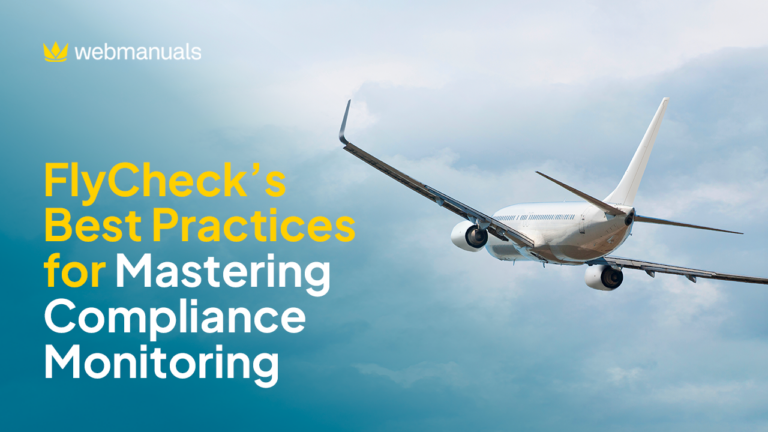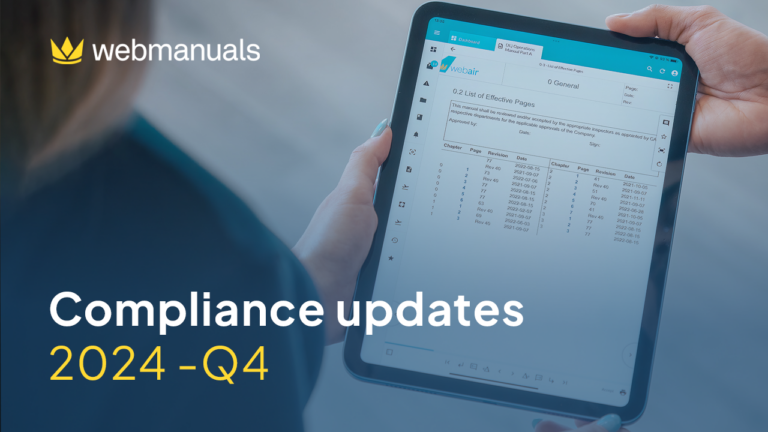By: Julia Larsson, Director of Operations EMEA – Web Manuals
With over 12 years of experience, at Web Manuals we have experienced firsthand digitalization in aviation, and we’re now witnessing the explosive immersion of Artificial Intelligence in the digitalized world. AI is no longer a futuristic concept; it is at the forefront of predictive maintenance, route optimization, and passenger services. AI algorithms analyze extensive datasets, not only enhancing decision-making processes but also significantly improving efficiency and reducing operational costs.
Particularly in MROs, the introduction of advanced robotics has become a cornerstone. Robotics are now applied to tasks such as aircraft inspection, component assembly, and maintenance operations, elevating precision and efficiency simultaneously.
MROs are the backbone of ensuring safety and operational readiness for flights, and are experiencing a paradigm shift with the infusion of digitalization. Digital records, AI-driven predictive maintenance, and robotics-assisted inspections are revolutionizing compliance processes, contributing to faster turnaround times, reduced downtime, and an overall enhancement of MRO efficiency.
Challenges for MROs
However, MROs are facing critical challenges when deciding to take the step towards digitalization. For example, integrating new digital and AI tools with existing MRO operations can be complex and time-consuming, potentially leading to disruptions in daily workflows. Employees are challenged to adopt new technologies, necessitating change management efforts and potentially impacting productivity during the transition.
This can be even more challenging when determining the tangible benefits and calculating the ROI for digital and AI implementations. Organizations may face uncertainties regarding the timeline for realizing financial gains. Furthermore, unexpected costs may arise during the implementation process or as a result of unforeseen technical issues, requiring additional financial resources. Without mentioning that we are facing a transition area where we identify a shortage of skilled workforce. The industry may face a shortage of professionals with the necessary skills to operate and manage advanced digital and AI tools, leading to increased competition for talent.
The correct digital tools simplify day-to-day operations
While the challenges are significant, organizations that successfully navigate these considerations can position themselves to reap the long-term benefits of improved efficiency, enhanced safety, and better customer satisfaction through the implementation of digital and AI tools in operations.
As MROs continue to face supply chain delays, labor shortages, and rising costs – whilst trying to mitigate the impact of part bottlenecks and restore balance sheets – implementing a digital compliance system that ditches paper documentation could bring about significant time and cost savings, at a relatively low cost.
Thus, replacing traditional paper documentation with a digital system can bring about significant time and cost savings for MROs. This transition to digitalization offers several advantages, contributing to increased efficiency and scalability, streamlined processes, and overall financial benefits.
Digital systems automate administrative tasks such as document creation, tracking, and management. This reduces the time spent on manual paperwork, allowing employees to focus on more value-added activities. Implementing the correct digital tools that work to simplify day-to-day operations will lay a solid foundation for digital growth. As the aviation industry landscape becomes increasingly complex, with growing pressure to deliver results, these foundations will allow MROs to face these new challenges head-first.
Also, digital documentation provides instant access to information from anywhere, eliminating the need for physical storage and making data readily available for authorized personnel. Teams can collaborate more efficiently as digital systems enable real-time sharing and editing of documents, fostering better communication and coordination internally.
New regulations: EASA Part 145
This is particularly relevant considering the changes to EASA Part 145, which applicability and implementation must be finalized by December of this year. The new regulation establishes that MROs must align their internal procedures to integrate a harmonized Management System tailored to their specific operational needs.
To achieve compliance with the new standards, it is crucial for MROs to introduce a Compliance Monitoring and Safety Management System. Therefore, the chosen system must assist users in efficiently monitoring regulations, rather than relying on unstructured lists in Excel. It’s crucial to include digital record-keeping systems that ensure safety, operational readiness, and regulatory compliance.
5 keys to start the digitalization journey
To address these challenges, is crucial to navigate the digital landscape effectively. Therefore, if you’re planning to start your digitalization journey, I have 5 key points to keep in mind:
1. Choose a Document Management System (DMS): Selecting the right DMS system is crucial as it forms the backbone of your digitalization efforts. Look for a system that meets your organization’s specific needs, including compliance requirements, workflow integration, scalability, and user-friendliness. Consider factors such as cloud-based solutions for accessibility, robust security features, and customizable options to tailor the system to your workflows.
2. New System = New Ways of Working: Transitioning to a digital environment requires a thorough review of internal responsibilities, workflows, and processes. Evaluate how tasks are currently performed and identify areas where digitization can enhance efficiency and productivity. Consider the training needs of your team to ensure they are equipped with the skills required to maximize the potential of the new DMS system.
3. Work on Change Management Internally: Digitalization goes beyond simply scanning paper documents—it entails a fundamental shift in how work is done. Engage with key stakeholders across your organization to garner support and understanding for the digitalization initiative. Identify champions who can drive the change process and empower teams with the knowledge and resources needed to embrace digital workflows effectively.
4. Set Your Priorities: Recognize that digital transformation is a journey, not a destination. Prioritize your objectives based on their strategic importance and feasibility. Focus on initiatives that deliver the most significant impact on operational efficiency, compliance, or customer satisfaction. By setting clear priorities, you can allocate resources effectively and measure progress towards your digitalization goals.
5. Engage in a Community: Joining a community of peers facing similar challenges in digital transformation can provide valuable insights and support. Exchange best practices, learn from others’ experiences, and leverage collective knowledge to overcome obstacles and accelerate your digitalization efforts. Engaging with a community allows you to tap into a wealth of expertise and stay informed about emerging trends and solutions in the MRO industry.
The Web Manuals solution
At Web Manuals, we have seen how this digital journey helps organizations to easily stay updated to comply with changing regulations, reducing the costs and time associated with manual revisions of paper documents. Our customers have identified a major impact on the implementation of Compliance Libraries linked directly into their manuals. Not only do they get full traceability of their compliance monitoring processes, but they also get automated alerts when the regulations change, highlighting exactly what needs to be updated. Our system serves as a tool for version control and revision tracking, minimizing the risk of using outdated or non-compliant documents. Also, facilitates the generation of automated reports required for regulatory compliance, reducing the manual effort involved in compiling data for regulatory authorities, and adding transparency in regulatory audits.

Our growing base of MRO customers is discovering that digitalization mitigates the impact of part bottlenecks and restores balance sheets. Digital aircraft records and digital compliance libraries support MROs to remain compliant with new and changing regulations. Web Manuals has become a tool that provides real-time updates, efficient documentation management, automated reporting and auditing, adaptability to regulatory changes, enhanced communication and collaboration, data accuracy and integrity, improved access to historical data, and seamless integration with other systems. These digital tools contribute to the agility and efficiency required for MROs to navigate the dynamic landscape of aviation regulations successfully.
System evolution
However, this marks just the beginning of an exciting evolution in our product, designed to cater even more precisely to the urgent demands of the aviation industry as we navigate safety intelligence together. We’re thrilled to announce the finalization of a prototype for an OEM PDF manager. This innovative tool includes a comprehensive Table of Contents for all interconnected PDFs and enables the seamless upload of thousands of documents simultaneously.
Additionally, we’re in the process of developing a Minimum Equipment List (MEL) template and editor. This solution offers enhanced control over MEL content, eliminating the complexities of table management. With an automatic population of raw data and customizable design options, our MEL editor streamlines workflow and enhances user experience.
Moreover, we’re integrating 3D Drawings directly into our platform, enhancing visual representation and interaction. This advancement allows users to manipulate images, rotate them in 3D space, zoom in for closer inspection, and dissect them as needed, all while maintaining vectorized clarity.
Our MRO customers have experienced a significant impact on their operations. Web Manuals not only provides compliance but becomes a cornerstone for efficiency and resilience.
Embarking on the digitalization journey with Web Manuals isn’t just about addressing present challenges—it’s about paving the way for sustained excellence in the dynamic aviation landscape.




